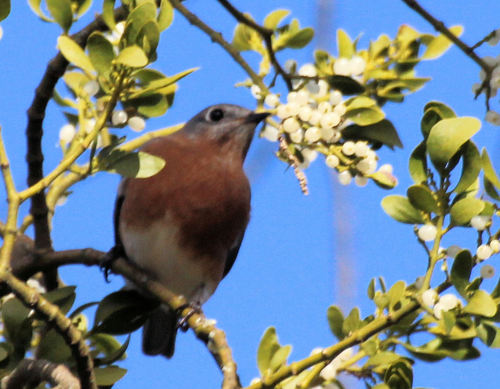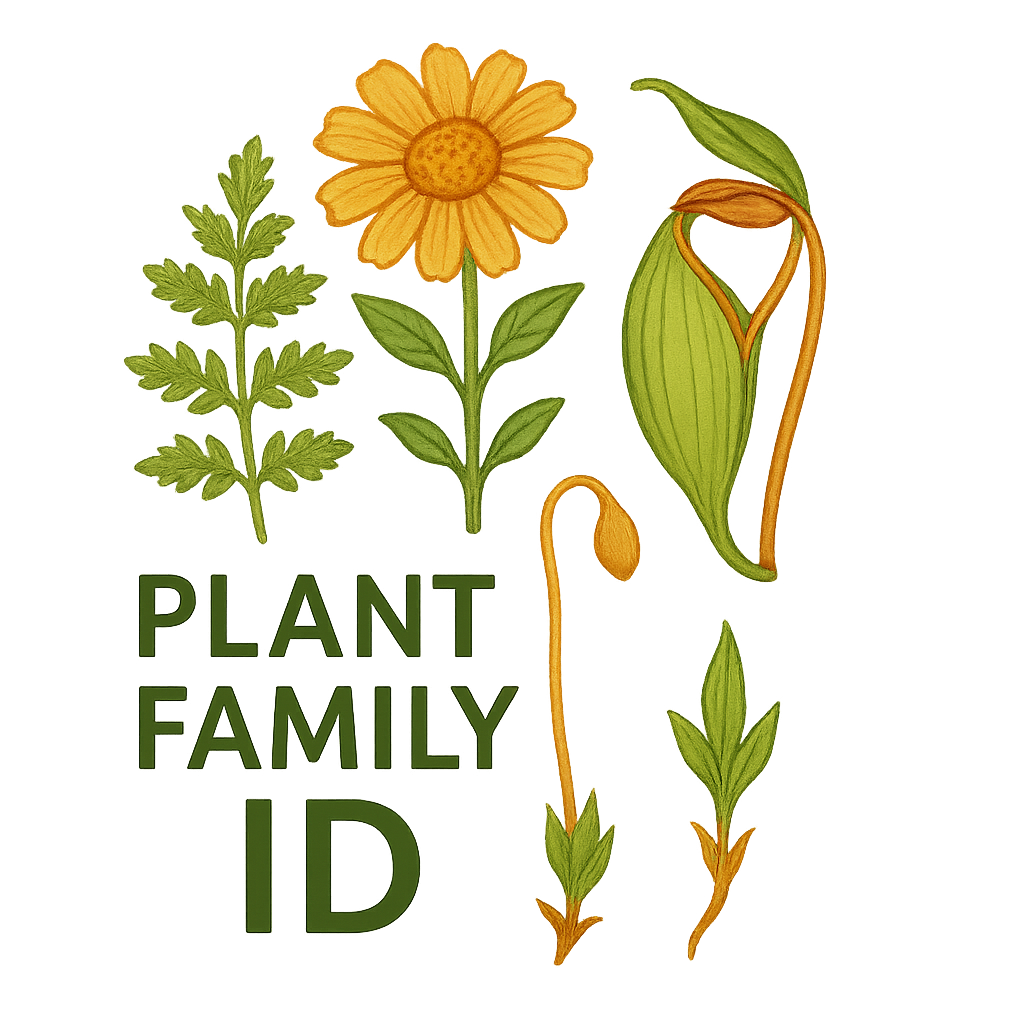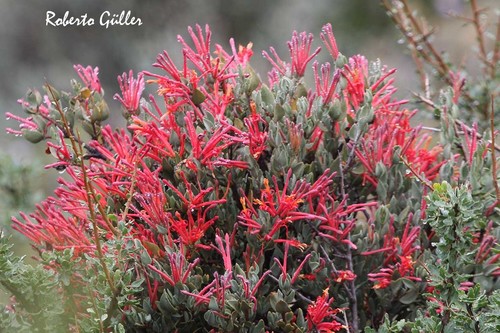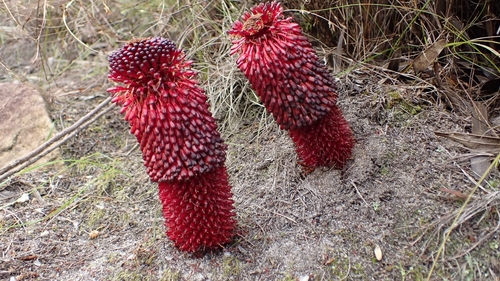Santalaceae
Sandalwood Family
Santalaceae is a large, cosmopolitan family primarily composed of hemiparasitic herbs, shrubs, and trees, including the well-known mistletoes (formerly Viscaceae) and sandalwoods. These plants photosynthesize but obtain water and mineral nutrients from host plants via specialized root or stem connections called haustoria. Leaves are variable (well-developed or scale-like), lacking stipules. Flowers are typically small, unisexual, with a single whorl of petaloid tepals, stamens opposite the tepals, and usually an inferior ovary. The fruit is commonly a drupe or berry.

Overview
The Santalaceae family, in its broad sense (sensu lato) as defined by modern phylogenetics (APG IV), includes around 44 genera and nearly 1000 species distributed worldwide in diverse climates and habitats. Its members are united by their hemiparasitic lifestyle, obtaining essential water and nutrients by tapping into the vascular systems of host plants through haustoria, while still performing photosynthesis with their own green tissues (leaves or stems).
This family includes ecologically and economically important groups. Sandalwoods (Santalum spp.) are prized for their aromatic heartwood used in incense, carving, and perfumery, leading to overharvesting of some species. Mistletoes (e.g., Viscum, Phoradendron, Arceuthobium) are aerial stem parasites that can significantly impact host tree health, playing roles in forest dynamics. Other members are inconspicuous root parasites. The inclusion of former families like Viscaceae and Eremolepidaceae within Santalaceae reflects a modern understanding based on molecular data, grouping together lineages with shared ancestry despite morphological diversity related to parasitic specialization.
The entire order Santalales, to which this family belongs, consists predominantly of parasitic plants, showcasing a major evolutionary radiation into this specialized nutritional strategy.
Quick Facts
- Scientific Name: Santalaceae
- Common Name: Sandalwood Family (includes mistletoes)
- Number of Genera: Approximately 44 (sensu lato)
- Number of Species: Approximately 1000 (sensu lato)
- Distribution: Cosmopolitan.
- Evolutionary Group: Eudicots - Santalales
- Lifestyle: Hemiparasitic (root or stem parasites).
Key Characteristics
Growth Form and Habit
Hemiparasitic herbs, shrubs, small trees, or aerial stem parasites (mistletoes). Plants are photosynthetic (green) but attach to host plants via specialized absorptive organs called haustoria (connecting to host roots or stems).
Leaves
Leaves are variable. They can be well-developed, simple, entire, arranged alternately or oppositely, or highly reduced to scales (especially in some mistletoes like Arceuthobium). Leaves always lack stipules (exstipulate).
Stems
Stems can be herbaceous or woody. In aerial parasites (mistletoes), stems are often brittle and jointed.
Roots
Root system may be reduced. Possess modified roots (or stem structures) forming haustoria that penetrate host tissues.
Sexuality and Inflorescence
Inflorescences are diverse, including cymes, spikes, heads, fascicles (clusters), or flowers may be solitary. Flowers are typically unisexual, with plants being monoecious (male and female flowers on the same plant) or dioecious (separate male and female plants). Some species have bisexual flowers.
Flowers
Flowers are generally small, inconspicuous, actinomorphic (radially symmetrical), and often greenish, yellowish, or whitish. They are typically 3- to 6-merous.
- Perianth: Consists of a single whorl of 3-6 petaloid tepals (perigone). There is no differentiation into sepals and petals. Tepals are often valvate (meeting edge-to-edge) in bud and may be free or fused at the base into a tube.
- Androecium (Stamens): Consists of 3-6 stamens, positioned opposite the tepal lobes and often attached to their bases (adnate).
- Ovary: Usually inferior (sometimes superior or half-inferior), composed of (1-)3-5 fused carpels. The ovary is typically functionally 1-locular (chamber indistinct or partitions breaking down early), with placentation usually free-central or basal. Style is usually single and short, with a capitate or lobed stigma.
Fruits and Seeds
The fruit is typically a fleshy drupe or berry, or sometimes a dry nut. It is usually 1-seeded. The berries of mistletoes (Viscum, Phoradendron) contain a sticky substance (viscin) that aids in seed dispersal by birds, adhering the seed to branches.
Chemical Characteristics
Plants often produce polyacetylenes. Alkaloids and tannins are also found in some members. Sandalwoods (Santalum) produce characteristic aromatic sesquiterpenoid oils (santalols) in their heartwood.
Field Identification
Identifying Santalaceae involves recognizing the hemiparasitic habit and specific floral features:
Primary Identification Features
- Habit: Hemiparasitic (check for haustorial connections on roots or stems if possible, or observe mistletoe habit). Plant is green (photosynthetic).
- Leaves: Variable (well-developed or scales), alternate or opposite, lacking stipules.
- Flowers: Small, actinomorphic, with a single whorl of 3-6 petaloid tepals (no distinct sepals/petals).
- Stamen Position: Stamens (3-6) positioned opposite the tepals.
- Ovary Position: Usually inferior.
- Fruit: Drupe, berry (often sticky in mistletoes), or nut.
Secondary Identification Features
- Sexuality: Flowers usually unisexual (plants monoecious or dioecious).
- Mistletoe Habit: Aerial stem parasites growing on branches of host trees. Stems often jointed.
- Distribution: Cosmopolitan.
Seasonal Identification Tips
- Year-round Features: Hemiparasitic habit (especially mistletoes), leaf characteristics (or lack thereof), and stem features are often visible year-round.
- Flowering/Fruiting Season: Varies widely. Small flowers can be inconspicuous. Fruits (especially mistletoe berries) are often more noticeable and persist for some time.
Common Confusion Points
Distinguishing Santalaceae from other parasitic or similar-looking plants:
- Loranthaceae (Showy Mistletoes): Also aerial hemiparasites (mistletoes) in Santalales. Distinguished by often having larger, more colorful flowers, typically with both calyx (a small rim called the calyculus) and corolla present (though sometimes reduced), and different stamen and ovary details.
- Cuscutaceae (Dodders - now often in Convolvulaceae): Holoparasitic (non-photosynthetic, often yellowish/orange) herbaceous vines that twine around hosts. Flowers are small but have distinct sepals and petals, and fruit is a capsule. Different order (Solanales).
- Orobanchaceae (Broomrape family): Hemiparasitic or holoparasitic herbs (root parasites). Distinguished by having clearly zygomorphic (bilaterally symmetrical) flowers with fused petals (sympetalous corolla). Different order (Lamiales).
- Non-parasitic plants with reduced flowers: Some wind-pollinated plants (e.g., Urticaceae, Ulmaceae in Rosales) have small flowers lacking petals, but they are not parasitic and have different floral structures (e.g., superior ovary, different stamen number/position).
The combination of hemiparasitic habit, exstipulate leaves (or scales), small flowers with a single tepal whorl, stamens opposite tepals, and usually inferior ovary is key for Santalaceae.
Field Guide Quick Reference
Look For:
- Hemiparasitic habit (green, attached to host)
- Herbs, shrubs, trees, or mistletoes
- Leaves variable (full or scales), exstipulate
- Flowers small, actinomorphic
- Perianth: Single whorl of 3-6 tepals
- Stamens (3-6) opposite tepals
- Ovary usually inferior
- Fruit a drupe, berry, or nut
Key Variations:
- Habit (root vs stem parasite; herb vs shrub vs tree)
- Leaf development (full vs scales)
- Flower sexuality (unisexual vs bisexual)
- Fruit type and texture (sticky berry vs dry drupe/nut)
Notable Examples
Santalaceae includes well-known parasitic plants like sandalwoods and mistletoes:

Santalum album
Indian Sandalwood
A small tropical tree native to southern India and Southeast Asia, highly valued for its fragrant heartwood. It is a root hemiparasite, attaching to the roots of various host trees. Overharvesting has made it vulnerable in the wild.

Viscum album
European Mistletoe
A common aerial hemiparasite (mistletoe) found on various deciduous trees in Europe and Western Asia. Forms dense, bushy clumps on host branches. Has opposite, leathery leaves and produces characteristic sticky white berries dispersed by birds. Known from Christmas traditions.

Phoradendron leucarpum
American Mistletoe, Oak Mistletoe
The common mistletoe found parasitizing deciduous trees (especially oaks) in eastern and central North America and Mexico. Similar habit to Viscum, with jointed stems, opposite leaves (sometimes reduced), and sticky white berries.
Phylogeny and Classification
Santalaceae is the largest family in the eudicot order Santalales. This order is remarkable because nearly all of its members are parasitic plants (ranging from hemiparasites to holoparasites). The circumscription of Santalaceae has expanded significantly based on molecular phylogenetic evidence, now typically including groups formerly treated as separate families, such as Viscaceae (leafy mistletoes), Eremolepidaceae (tropical American mistletoes), and others.
The Santalales order itself represents one of the early diverging lineages of core eudicots, not closely allied with major groups like Rosids or Asterids (though sometimes placed near Caryophyllales). Understanding the relationships within Santalales, including the expanded Santalaceae, illuminates the multiple origins and evolutionary pathways of parasitism in flowering plants.
Position in Plant Phylogeny
- Kingdom: Plantae
- Clade: Angiosperms (Flowering plants)
- Clade: Eudicots
- Clade: Core Eudicots
- Order: Santalales
- Family: Santalaceae (sensu lato, including Viscaceae etc.)
Evolutionary Significance
Santalaceae (sensu lato) is crucial for studying:
- Evolution of Parasitism: The Santalales order provides a major arena for studying the origins and diversification of parasitic lifestyles in plants, with Santalaceae showcasing various degrees of dependence and adaptation (root vs. stem parasitism, leaf reduction).
- Haustorial Development: The structure and function of haustoria, the specialized organs for host attachment and nutrient transfer, are key evolutionary innovations.
- Co-evolution: Interactions between parasitic Santalaceae (especially mistletoes) and their host plants, as well as interactions with seed dispersers (like birds for sticky mistletoe berries), illustrate co-evolutionary processes.
- Economic Botany: The overexploitation of Santalum highlights issues in sustainable harvesting and conservation of economically important plant resources.
- Ecological Roles: Mistletoes can act as keystone species in some ecosystems, influencing host populations and providing resources (food, nesting sites) for animals, despite being parasites.



